Park Kultury Парк культуры | ||||||||||||||||||||||||||||||||||||||||||||||||||||||||||||||||||||||||||||||||||||||||||||||||||||||||||||||||||||||||||||||||||||||||||||||||||||||||||||||||||
|---|---|---|---|---|---|---|---|---|---|---|---|---|---|---|---|---|---|---|---|---|---|---|---|---|---|---|---|---|---|---|---|---|---|---|---|---|---|---|---|---|---|---|---|---|---|---|---|---|---|---|---|---|---|---|---|---|---|---|---|---|---|---|---|---|---|---|---|---|---|---|---|---|---|---|---|---|---|---|---|---|---|---|---|---|---|---|---|---|---|---|---|---|---|---|---|---|---|---|---|---|---|---|---|---|---|---|---|---|---|---|---|---|---|---|---|---|---|---|---|---|---|---|---|---|---|---|---|---|---|---|---|---|---|---|---|---|---|---|---|---|---|---|---|---|---|---|---|---|---|---|---|---|---|---|---|---|---|---|---|---|---|---|
| Moscow Metro station | ||||||||||||||||||||||||||||||||||||||||||||||||||||||||||||||||||||||||||||||||||||||||||||||||||||||||||||||||||||||||||||||||||||||||||||||||||||||||||||||||||
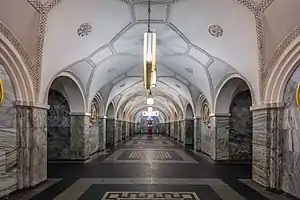 | ||||||||||||||||||||||||||||||||||||||||||||||||||||||||||||||||||||||||||||||||||||||||||||||||||||||||||||||||||||||||||||||||||||||||||||||||||||||||||||||||||
| General information | ||||||||||||||||||||||||||||||||||||||||||||||||||||||||||||||||||||||||||||||||||||||||||||||||||||||||||||||||||||||||||||||||||||||||||||||||||||||||||||||||||
| Location | Ostozhenka Street, Khamovniki District, Central Administrative Okrug | |||||||||||||||||||||||||||||||||||||||||||||||||||||||||||||||||||||||||||||||||||||||||||||||||||||||||||||||||||||||||||||||||||||||||||||||||||||||||||||||||
| Coordinates | 55°44′09″N 37°35′29″E / 55.7357°N 37.5915°E | |||||||||||||||||||||||||||||||||||||||||||||||||||||||||||||||||||||||||||||||||||||||||||||||||||||||||||||||||||||||||||||||||||||||||||||||||||||||||||||||||
| Owned by | Moskovsky Metropoliten | |||||||||||||||||||||||||||||||||||||||||||||||||||||||||||||||||||||||||||||||||||||||||||||||||||||||||||||||||||||||||||||||||||||||||||||||||||||||||||||||||
| Line(s) | ||||||||||||||||||||||||||||||||||||||||||||||||||||||||||||||||||||||||||||||||||||||||||||||||||||||||||||||||||||||||||||||||||||||||||||||||||||||||||||||||||
| Platforms | 1 | |||||||||||||||||||||||||||||||||||||||||||||||||||||||||||||||||||||||||||||||||||||||||||||||||||||||||||||||||||||||||||||||||||||||||||||||||||||||||||||||||
| Tracks | 2 | |||||||||||||||||||||||||||||||||||||||||||||||||||||||||||||||||||||||||||||||||||||||||||||||||||||||||||||||||||||||||||||||||||||||||||||||||||||||||||||||||
| Connections | Trolleybus: Б, 10, 28, 31, 31к, 79 | |||||||||||||||||||||||||||||||||||||||||||||||||||||||||||||||||||||||||||||||||||||||||||||||||||||||||||||||||||||||||||||||||||||||||||||||||||||||||||||||||
| Construction | ||||||||||||||||||||||||||||||||||||||||||||||||||||||||||||||||||||||||||||||||||||||||||||||||||||||||||||||||||||||||||||||||||||||||||||||||||||||||||||||||||
| Structure type | Deep pylon tri-vault | |||||||||||||||||||||||||||||||||||||||||||||||||||||||||||||||||||||||||||||||||||||||||||||||||||||||||||||||||||||||||||||||||||||||||||||||||||||||||||||||||
| Depth | 40 metres (130 ft) | |||||||||||||||||||||||||||||||||||||||||||||||||||||||||||||||||||||||||||||||||||||||||||||||||||||||||||||||||||||||||||||||||||||||||||||||||||||||||||||||||
| Platform levels | 1 | |||||||||||||||||||||||||||||||||||||||||||||||||||||||||||||||||||||||||||||||||||||||||||||||||||||||||||||||||||||||||||||||||||||||||||||||||||||||||||||||||
| Parking | No | |||||||||||||||||||||||||||||||||||||||||||||||||||||||||||||||||||||||||||||||||||||||||||||||||||||||||||||||||||||||||||||||||||||||||||||||||||||||||||||||||
| Other information | ||||||||||||||||||||||||||||||||||||||||||||||||||||||||||||||||||||||||||||||||||||||||||||||||||||||||||||||||||||||||||||||||||||||||||||||||||||||||||||||||||
| Station code | 076 | |||||||||||||||||||||||||||||||||||||||||||||||||||||||||||||||||||||||||||||||||||||||||||||||||||||||||||||||||||||||||||||||||||||||||||||||||||||||||||||||||
| History | ||||||||||||||||||||||||||||||||||||||||||||||||||||||||||||||||||||||||||||||||||||||||||||||||||||||||||||||||||||||||||||||||||||||||||||||||||||||||||||||||||
| Opened | 1 January 1950 | |||||||||||||||||||||||||||||||||||||||||||||||||||||||||||||||||||||||||||||||||||||||||||||||||||||||||||||||||||||||||||||||||||||||||||||||||||||||||||||||||
| Rebuilt | February 2011[1][2] – 30 March 2012[3] | |||||||||||||||||||||||||||||||||||||||||||||||||||||||||||||||||||||||||||||||||||||||||||||||||||||||||||||||||||||||||||||||||||||||||||||||||||||||||||||||||
| Previous names | Park Kultury Imeni Gorkogo | |||||||||||||||||||||||||||||||||||||||||||||||||||||||||||||||||||||||||||||||||||||||||||||||||||||||||||||||||||||||||||||||||||||||||||||||||||||||||||||||||
| Services | ||||||||||||||||||||||||||||||||||||||||||||||||||||||||||||||||||||||||||||||||||||||||||||||||||||||||||||||||||||||||||||||||||||||||||||||||||||||||||||||||||
| ||||||||||||||||||||||||||||||||||||||||||||||||||||||||||||||||||||||||||||||||||||||||||||||||||||||||||||||||||||||||||||||||||||||||||||||||||||||||||||||||||
| ||||||||||||||||||||||||||||||||||||||||||||||||||||||||||||||||||||||||||||||||||||||||||||||||||||||||||||||||||||||||||||||||||||||||||||||||||||||||||||||||||
| Location | ||||||||||||||||||||||||||||||||||||||||||||||||||||||||||||||||||||||||||||||||||||||||||||||||||||||||||||||||||||||||||||||||||||||||||||||||||||||||||||||||||
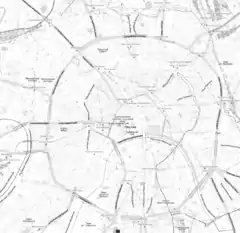 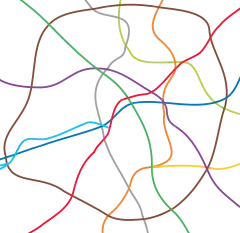 Park Kultury Location within Central Moscow | ||||||||||||||||||||||||||||||||||||||||||||||||||||||||||||||||||||||||||||||||||||||||||||||||||||||||||||||||||||||||||||||||||||||||||||||||||||||||||||||||||
Park Kultury (Russian: Парк культу́ры) is a Moscow Metro station in the Khamovniki District, Central Administrative Okrug, Moscow. It is on the Koltsevaya line (Circle line), between Oktyabrskaya and Kiyevskaya stations. Park Kultury opened on 1 January 1950.
Design
The station is a standard pylon tri-vault, that was built in the flamboyance of the 1950s. Architect Igor Rozhin (who would then design the Luzhniki Stadium) applied a classic sport recreational theme to match the connotation with the ancient-Greek inspired transfer station. This includes large and imposing pylons faced with grey marble that came directly from Georgia. The floor is laid with black and grey granite tiles imitating a carpet. The walls are faced with white marble and labradorite. Decoratively the station contains 26 circular bas-reliefs by Iosif Rabinovich which depict sporting and other leisure activities of the Soviet youth.
The white vault of the station contains complex geometry which repeats that of the arches, and along the apex are suspended a set of intricate hexagonal chandeliers. Rozhin later admitted that he made a grave error in choosing to place the chandeliers amid the arches, not between them, that way he would have avoided giving the bas-reliefs a double shadow. At the end of the station is a massive marble wall with a small profile bas-relief of Maxim Gorky. The station was initially called "Park Kultury imeni Gorkogo" (Парк Культуры имени Горького) but during the 1980 Moscow Olympics this was shortened as the Russian announcements were repeated in English and French during the games. After the Olympics, the shorter name was retained. The original long form appears in bronze letters next to Gorky's image.
The station has a large imposing vestibule located on the corner of Komsomolsky Avenue and Garden Ring next to the Krymsky Bridge which was co-designed with Rozhin by Yelena Markova. Originally Rozhin planned for an extended arcade modeled after Russian trading rows, but this was rejected in favour of a more traditional design. The large building features a central dome, and inside has four bas-reliefs of sportsmen, and another one on its portico outside (all by G. Motovilov). The vestibule also doubles as a transfer to the Sokolnicheskaya line.
As the station was initially terminus, a set of reversal sidings exist in front of it, also from them runs a service branch to the Sokolnicheskaya line which was used initially as the primary way of transferring rolling stock to the station before the opening of the Koltsevaya line's depot in 1954.
Reconstruction
On 14 January 2011, Moscow Metro authorities announced their plans to close the station on 5 February 2011 so as to replace the ageing escalators. Park Kultury was supposed to open in December 2011[1][2] but the date was shifted to 30 March 2012 due to delays in shipping new escalators.[4] and opened the station on 28 April.[3]
Image gallery
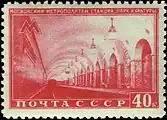 The station on a 1950 postage stamp
The station on a 1950 postage stamp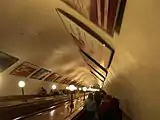 Escalators (from the Park Kultury on the Sokolnicheskaya line)
Escalators (from the Park Kultury on the Sokolnicheskaya line)_(4473145168).jpg.webp) Station platform
Station platform Lanterns
Lanterns Bas-relief
Bas-relief Figure skaters
Figure skaters
References
- 1 2 "Park Kultury station (Circle line) to be closed for reconstruction". Moskovsky Metropoliten. 14 January 2011. Archived from the original on 23 December 2015. Retrieved 15 January 2011.
- 1 2 "Станция "Парк культуры" Кольцевой линии метро закрывается почти на год". NEWSmsk.com. 14 January 2011. Retrieved 15 January 2011.
- 1 2 "Park Kultury to open after reconstruction". Moskovsky Metropoliten. 27 April 2012. Archived from the original on 23 December 2015. Retrieved 30 April 2012.
- ↑ "В метро извинились за долгий ремонт "Парка культуры" и пообещали открыть станцию в субботу". NEWSmsk.com. 26 April 2012. Retrieved 30 April 2012.